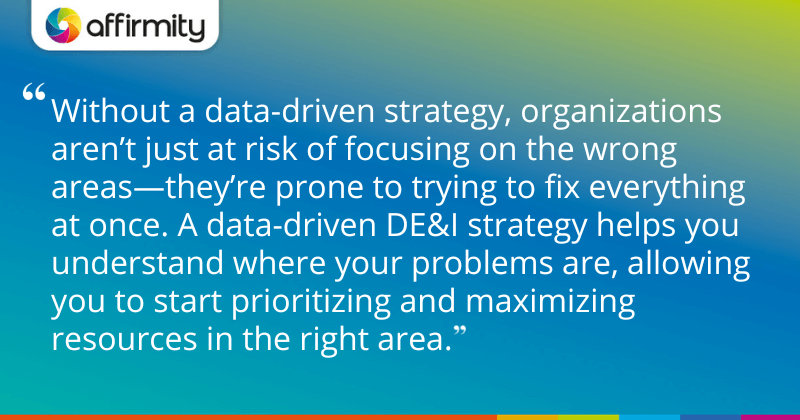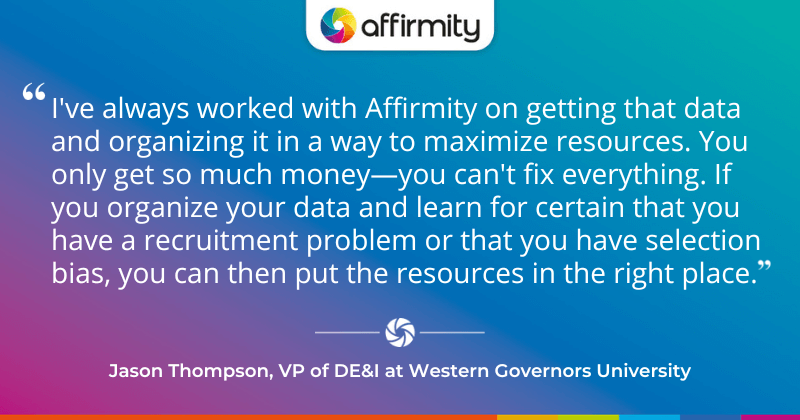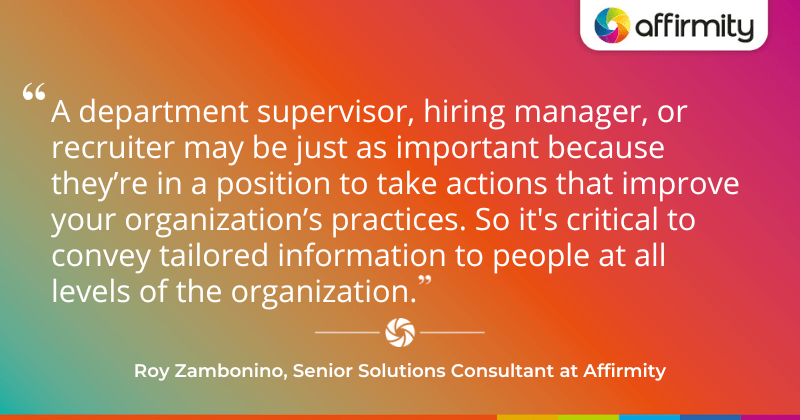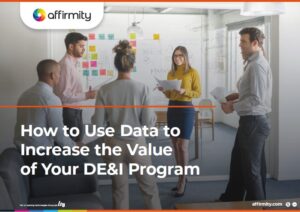Organizations sometimes feel their DE&I program isn’t entirely successful in driving organizational change, even when they’ve expended significant effort in executing it. So what’s the source of this doubt? Often, it’s a lack of data—both data that proves DE&I is working, and data underpinning the strategy from day one. In this blog post, we examine why the only way to build an effective DE&I strategy is with data, before outlining some key strategies for achieving a data-driven strategy.
Why Should You Develop a Data-Driven DE&I Strategy?
Data helps you prove success, observe issues, and steer programs toward areas of opportunity. We asked a panel of Affirmity experts and collaborators why organizations should develop data-driven DE&I strategies, and they gave us these three key reasons.

1) Data Ensures Your Program Is More Practical and Less Theoretical
Jason Thompson, VP of DE&I at Western Governors University, consultant, and a long-time Affirmity user and collaborator, describes the benefits of a data-driven DE&I strategy: “You don’t know if you’re successful if you don’t know where you started from, so that’s why it’s so important to get data first.”
Furthermore, Thompson stresses the potential pitfalls of neglecting data collection with an example from his own experience: “Years ago, I consulted with a business that, having already established a diversity committee, had decided that they were going to focus on recruitment. I asked them: ‘well, how do you know you have a recruitment problem?’ The truth was, they didn’t know. And when we looked at the data, we found out there was no recruitment issue—the data showed people were already applying. But they weren’t being selected.”
There’s always a risk that companies without access to robust data will over-emphasize their recruitment efforts to fill diversity gaps. And it can be frustrating to expend this effort without yielding outcomes. But if you have unmeasured selection bias, you won’t know that you should actually be deploying unconscious bias training and focusing your attention on your selection procedures.
AVOIDING TRAINING FOR TRAINING’S SAKE | ‘5 Ways to Protect Your Organization From Self-Sabotaging DE&I Training’

2) Data Helps You Concentrate Limited Resources More Effectively
Without a data-driven strategy, organizations aren’t just at risk of focusing on the wrong areas—they’re prone to trying to fix everything at once. A data-driven DE&I strategy helps you understand where your problems are, allowing you to start prioritizing and maximizing resources in the right area.
Thompson explains how he approaches the issue: “I’ve always worked with Affirmity on getting that data and organizing it in a way to maximize resources. You only get so much money, and typically diversity programs are underfunded—you can’t fix everything. If you organize your data and learn for certain that you have a recruitment problem or that you have selection bias, you can then put the resources in the right place.”

3) (Clean) Data Helps You Align With Your Organization’s Mission, Vision and Values
Not only does data help show your organization’s current position and progress, but it also helps you develop KPIs around your DE&I strategy. The KPIs you develop should naturally be aligned with your company’s strategic goals. This alignment is critical for integrating DE&I practices into your business’ collective approach. It makes it easier to tell the DE&I story to not only your executive team and employees, but also your external audience.
Of course, a data-driven DE&I strategy can only be achieved through robust, clean, accurate data. If employee, historical, or applicant data is incomplete or inaccurate, it won’t be possible to tell an effective story, so it’s critical to thoroughly review data extracted from HRIS systems prior to developing suitable KPIs for the organization.
Proper collection of data is only one part of the puzzle—you have to be able to convey that information to the right people, in the right way. “It’s not just about the leaders at the top of your organization,” says Roy Zambonino, Senior Solutions Consultant at Affirmity. “A department supervisor, hiring manager, or recruiter may be just as important because they’re in a position to take actions that improve your organization’s practices. So it’s critical to convey tailored information to people at all levels of the organization.”
MORE ON CLEAN DATA ISSUES | ‘4 Signs That Your Applicant Data Won’t Pass an OFCCP Audit’
5 Ways to Put Data in the Driving Seat
To drive value from your DE&I program, we recommend:
- Establishing executive buy-in early in the program to ensure maximum traction.
- Being mindful of using clean, accurate, reliable data to avoid skewing your story. This is especially important in an environment where holes in your data could lead to repercussions.
- Setting reasonable, achievable goals. While there’s nothing wrong with being aspirational, certain factors are not always fully in your control.
- Monitoring your data and being predictive rather than reactive
- Building partnerships and not doing it all alone—institutions, community groups, and consultants can help make data collection and program execution easier.
On this last point, Thompson is particularly vocal: “It’s easy to feel like you’re on your own when you’re running a diversity program, and people think they’ve got to do the data themselves. And honestly, data is hard work. You may think ‘well, we have an internal data department’, but it may take you six months before they can even get to your project. And that can be an eternity for a practitioner newly in the position. If you work with a third party instead, you’d be up and running in a matter of weeks and working on outcomes. It’s certainly worth considering.”
LEARN ABOUT OTHER BIG ISSUES IN DE&I | ‘8 Big AAP, EEO, and DE&I Themes From Our NILG 2023 Advice Board’
Learn About Data-Backed Goal Setting and Further Key Strategies: Download Our Guide
This blog post is an extract from our full guide, “How to Use Data to Increase the Value of Your DE&I Program”. In this guide, Senior Solutions Consultant Roy Zambonino, DE&I Consultant and Product Manager Joe Valenzuela, and VP of DE&I at Western Governors University, Jason Thompson, explore a full range of considerations for data-driven decision-making.
Now that you’ve read about the rationale behind the approach, dive into the full ebook to learn:
- Why it’s important to set realistic goals and targets
- How organizations can use data to establish those goals and targets
- How organizations can hold leaders accountable for DE&I objectives
- What tools and practices are needed to manage DE&I efforts

Download the full guide today.
About the Author

Jeffery D. Lewis is co-managing director for Affirmity. He oversees professional services and sales for Affirmity’s affirmative action consulting services and diversity planning programs. He leads teams of consultants who deliver services spanning affirmative action, EEO compliance, and diversity planning. He also oversees a team of experts who specialize in evaluating allegations of discriminatory employment practices.
With more than 35 years with the company, Mr. Lewis has assisted hundreds of clients across numerous industries. He regularly presents executive seminars on all aspects of affirmative action and diversity management.
